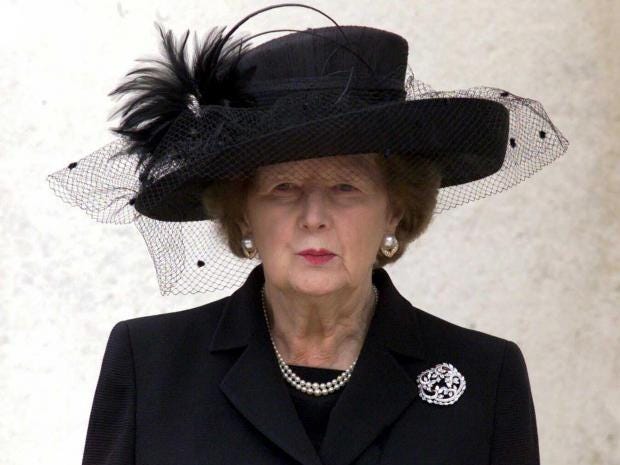
Whatever your political leanings, it is undeniable that Margaret Thatcher was an immensely influential figure. Foremost as the first female British Prime Minister and champion of neo-liberalism. But, as the Victoria and Albert Museum have suggested by recently introducing items of her clothing into their permanent collection, in her dress, too.
The same week that BBC Four’s Woman’s Hour named Baroness Thatcher as the most influential woman of the last 70 years, the museum in South Kensington unveiled what they have identified as three iconic outfits worn by the late Prime Minister including the blue wool Aquascutum suit she wore to the Conservative Party Conference in Blackpool in 1987 and again to cast her ballot in that year’s winning election. A custom-designed brocade suit and taffeta opera cape designed by Marianne Abrahams by Aquascutum she wore to the Lord Mayor’s Banquet in 1979, and a black slub silk hat with feathers and velvet-flecked tulle designed by Deida Acero, which she wore to her husband Sir Denis’ funeral in 2003 and again at memorial for US President Ronald Regan in the same year, are also appearing.
Reconsidering Thacther’s dress-sense seems particularly important in a year when the UK gained its second female Prime Minister – without a little controversy surrounding her own fashion-sense and its costs – and women have held (in Germany) and narrowly lost (in the US) the world’s most important seats of power.
Jane Tynan, a lecturer in fashion history at Central St Martin’s School of Art in London, says that our tendency to scrutinise what women wear is a reflection of a sexist society that draws attention away from the real work they do in politics.
Nevertheless, she argues that Thatcher was very aware of her image and used clothing as a tool of power. But a trend setter she was not. Instead, the former Prime Minster adopted the signature “power-dressing” style of the 1980s.
“Like many politicians, she created a personal style to project political values. She followed trends to some extent but matched this with style references to emphasise her conservative values,” explains Dr Tynan.
“With ‘power dressing’ she could tap into the image of a career woman but her reputation as a fierce leader then drove her to wear clothes that might ‘soften’ her image, which was why she wore pussy bow blouses. A symbol of the past reflecting a more conservative femininity, the pussy bow blouse clashed with the aggressive power suits.
“This was the paradox of the Thatcher image: at once she sought to embody conservative values while also seeking to assert her right to power as a woman. Conservatism did not necessarily embrace women in positions of power. What Thatcher’s wardrobe represents are the contradictions of a woman leader gaining power through a Conservative ideology, which limits female power in wider society.”
In turn, the dark Conservative blue was a recurring colour in her wardrobe as, says Dr Tynan, was her choice of heritage brand Aquascutum.
“Here she sought to represent a certain version of Britishness that would see her share in their strong tradition of Military and Royal clients.”
Three decades later, clothing is still important for politicians – and still perilous for women.
“It is clear from the choices made by Hilary Clinton in the run up to the recent US Presidential election that clothing matters for all politicians,” says Dr Tynan of the Democratic hopeful who became synonymous with pantsuits.
Commenting on the recent furore surrounding Theresa May’s £1,000 leather trousers she adds: “The PM was criticised for what she was wearing simply because she is a woman. It is clearly unfair that women come under more scrutiny than men in this regard, particularly as male politicians often purchase expensive clothes, for instance, Savile Row suits.”
Yet, men still don’t quite escape scrutiny either, she adds. As Labour leader Jeremy Corbyn knows all too well, clothing is also a symbol of values for men. And yet, in a world of spin and PR, politicians must know exactly what they are doing.
“While Theresa May’s expensive fashionable trousers came under criticism, Jeremy Corbyn has in the past been criticised for being scruffy and not spending enough on his clothes.”
“But we cannot ignore the fact that people are also using clothing – and its symbolism – to wage political wars because it is such a powerful marker of social values.”
[sOURCE:-The Independent]






